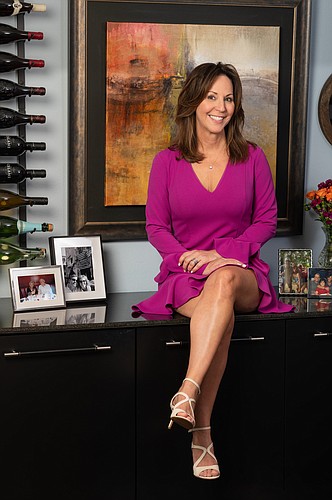- April 8, 2025
-
-
Loading

A degree in psychology isn’t required to practice interior design. But it can help.
Tracee Murphy, CEO and principal designer of Sarasota-based interior design firm Trade Mark Interiors, pursued a career in design after first earning a psychology degree. “It wasn’t until I was out of college and had my own place that I started to find it and fall in love with it,” Murphy says. “I began to do my house, my neighbor’s house and neighbor’s cousin’s house. It just naturally evolved.”
Murphy went back to school to earn an interior design degree when she had two young children and a part-time job. After about five years of working in interior design, she realized her degree in psychology was coming in handy while she worked closely with clients, in dealing with conflict between spouses and navigating differing opinions on projects.
This year, her firm marks 20 years in business. Murphy started Trade Mark Interiors in Pennsylvania and moved the firm to Sarasota 14 years ago. Her firm works on residential and commercial projects, with about 60% residential and 40% commercial. While not disclosing specific revenue figures, Murphy says the company did more than $1 million in 2019 revenue and is on track to grow 25% in 2020.
And despite the pandemic, the firm isn’t slowing down. It has big projects in progress, and Trade Mark is getting calls from companies that want help downsizing their offices.
The majority of Trade Mark’s work comes from doing additional projects for existing clients or from clients referring neighbors, friends and family. For instance, the company did a couple’s bathroom renovation, and when they moved, Trade Mark designed their new home. When the husband moved offices, the firm designed a new corporate office for him. “It’s a very close relationship when you’re designing with someone,” Murphy says. “You’re talking about, ‘How do you live? How do you and your husband use your bathroom?’”
With project cycles that can last a year or two, bonds naturally form. “We’re friends with a lot of our clients,” she says. “We’re included in a lot of their celebrations and functions. It’s definitely an ongoing relationship.”
Murphy, who has three employees, says a team approach also helps set the firm apart. With an office manager and three designers, projects have the benefit of multiple perspectives. “It’s not, you take this job, and I take that job,” she says. “We collectively work on every project. I think that makes a big difference.”
The multidesigner concept often helps the firm secure work. “When talking to clients and securing new clients, it’s come up over and over again,” Murphy says. “They knew nothing would fall through the cracks, timelines would be met, and they felt excited about three designer’s eyes.”
‘We collectively work on every project. I think that makes a big difference.’ — Tracee Murphy, Trade Mark Interiors
Another key aspect of bringing new clients on board is an education process. “I know enough to educate my clients at the beginning of the project,s so they understand our value, what we do, and they understand the difference between us and bargain shopping on the internet,” Murphy says. “I’ve also done this long enough to understand the red flags of people who may not understand that. I learned the value of saying no. We don’t just take any job. We qualify our clients as much as they qualify us.”
During the pandemic, while some companies plummeted, Trade Mark’s business has spiked. “We are extremely busy,” Murphy says. “We’re getting a lot of phone calls for renovations, new construction and all different-sized projects.” Part of that, she thinks, is because people are spending more time at home and deciding it’s time to make upgrades. The largest residential project the firm has started since the pandemic is a 9,000-square-foot whole house renovation.
The firm has kept projects moving during the pandemic by harnessing a resource called Material Bank that gathers vendor samples, from wallpaper to fabric to flooring. Instead of running around to 25 showrooms, the firm can have samples shipped to them. “It’s a resource we used 15% to 25% of the time prior to COVID-19,” Murphy says. “Since April, we started using Material Bank 80% to 90% of the time. It enabled us to keep our new construction projects moving along without missing a beat.”
On the commercial side, Trade Mark received several inquiries lately from companies moving into smaller offices because employees are working from home. They need Trade Mark’s help to bring their brand into a new space and make it functional.
Despite a busy pandemic period, Murphy is still focused on the company’s future. She wants Trade Mark to remain a boutique design firm, but she’d like to have a full residential division and commercial division. “The goal is to have a duplicate team of what we have now,” she says. “We’re going to keep trucking along and following the plan.”